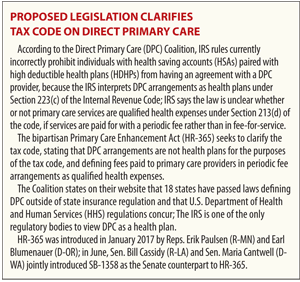With healthcare premium costs increasing 17 to 23 percent each year, Scott Willis, risk manager for Tapani Inc. (previously Tapani Underground) was looking for a way to reduce his company’s healthcare-related expenses without shifting the costs to Tapani’s employees.
“We wanted to stay in front of the cost curve, but still offer the best possible benefits,” said Willis.
The Battle Ground-based heavy civil contracting company, which has doubled in size to more than 450 employees over the last two to three years, reached out to their insurance broker, Tyson Fuehrer, vice president of the Life and Health Department at Biggs Insurance Services (headquartered in Vancouver since 1935), for a creative solution.
“Employers just want to take care of their employees, and find a way to pay for it,” said Fuehrer.
Working together, Willis and Fuehrer developed a creative approach to healthcare benefits that has generated the desired savings, in addition to increasing employee satisfaction. Tapani transitioned to partial self-funded health insurance in addition to adopting the “direct primary care” (DPC) model.
Partially self-funded insurance means that the firm pays all medical claims and Rx costs directly, but still uses an insurance carrier that provides a network of hospitals and facilities for specialized care and stop-loss insurance for higher claims.
The DPC model is an alternative to the more common fee-for-service insurance billing characterized by co-pays and deductibles. With the DPC model, members (patients) pay a monthly, quarterly or annual fee that covers all or most primary care services including clinical, laboratory and consultative services, as well as care coordination and comprehensive care management.
DPC isn’t a new idea. But, said Fuehrer, it has historically been restricted to large employers (1,000+ employees), who build an on-site primary care clinic.
“The challenge is that there are few businesses in Clark County that large,” said Fuehrer. “What we’ve done is paired multiple employers together to offer this sort of model. It makes financial sense for both the providers and the employers.”
Tapani paired with another nearby, similarly sized company, and built a DPC clinic in Battle Ground last year (employees still must participate in the company’s medical plan, which covers non-primary care health expenses).
According to both Fuehrer and Willis, DPC benefits employer and employee by providing substantial savings, a greater degree of access to and time with physicians and increased employee wellness.
By removing the cost barrier (co-pays and deductibles), explained Fuehrer, employees are more willing to see their primary care physician. A typical DPC plan costs between $25 and $85 per month, according to a recent Wall Street Journal article. The result, said Seth Sjostrom, chief strategy officer for EverMed DPC, LLC, the Camas-based DPC network with which Tapani is working, is that health conditions do not spiral out of control and expensive emergency room visits are reduced; the more foundational care that is delivered, the more the costs go down.
Tapani’s experience shows this to be true. Willis stated that Tapani’s claims and Rx costs have fallen 45 percent since offering the DPC model to employees. ER visits are down 25 percent, and hospital admits are down 50 percent.
“These results show that the model works,” said Willis.
Fuehrer said that another advantage of the DPC model is that patients get to spend more time with their physician. DPC providers typically spend about a half-hour with each patient, whereas the industry average patient visit for a fee-for-service physician is about seven minutes. This extra time means the doctor and patient can discuss health and medication concerns and necessary lifestyle changes in more detail and results in fewer specialist referrals and a higher rate of treatment acceptance.
Another benefit of the DPC model is its focus on wellness outreach, which further enables employers to control healthcare costs while improving employee health. For example, said Fuehrer, consider an employee who doesn’t have a primary care provider, and then discovers through a major health incident that he or she has been diabetic for five years. Claims costs jump from zero to $100,000 in a single year. A health coach, on the other hand, could have engaged with that employee much sooner and potentially avoided a crisis through lifestyle modification. Employers can also tailor outreach programs to their employee health, such as designing a program in response to a spike in lower back pain incidents.
Willis said that being partially self-funded provides the ability to see where the claims dollars are going, which helps the firm focus on wellness programs that can drive claims costs down.
 “The wellness programs play a big part in controlling costs,” said Willis. Tapani incentivizes employees’ participation in the DPC model, including wellness outreach programs, by offering participants a reduction in their insurance premiums.
“The wellness programs play a big part in controlling costs,” said Willis. Tapani incentivizes employees’ participation in the DPC model, including wellness outreach programs, by offering participants a reduction in their insurance premiums.
According to Willis, employee feedback on the DPC model has been very positive. Participation in the model has increased 40 percent over the last year, from 400 members to 620 members (including dependents).
“Once word of mouth got out about the extra time doctors spend with their patients, how convenient the clinics are and the lack of co-pays,” said Willis, “employee participation has steadily increased.”
Fuehrer said that the number of clinics wanting to contract for the DPC model is also growing, as is interest in the business community.
“We started with two employers, added a couple more, and now quite a few of our clients are looking at this,” he said.
An employer such as Tapani can contract with several clinics so that all employees have the opportunity to visit a clinic either near their workplace or their home.
“The bottom line is that the DPC model is working really well,” concluded Willis. “Employees can still go to a hospital or a specialist, but if they go to the DPC clinic there is no deductible or co-pay, the doctors are more personable and the health coaching, wellness programs and disease management help bring down costs.”



